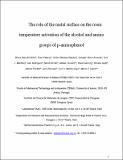Por favor, use este identificador para citar o enlazar a este item:
http://hdl.handle.net/10261/224682COMPARTIR / EXPORTAR:
 SHARE SHARE
 CORE
BASE CORE
BASE
|
|
| Visualizar otros formatos: MARC | Dublin Core | RDF | ORE | MODS | METS | DIDL | DATACITE | |

| Título: | Role of the Metal Surface on the Room Temperature Activation of the Alcohol and Amino Groups of p-Aminophenol |
Autor: | Ruiz del Árbol, Nerea CSIC; Palacio, Irene CSIC ORCID; Sánchez-Sánchez, Carlos CSIC ORCID ; Otero, Gonzalo CSIC ORCID; Martínez, José I. CSIC ORCID ; Rodríguez, Luis; Serrate, David CSIC ORCID ; Cossaro, Albano; Lacovig, Paolo; Lizzit, Silvano; Verdini, Alberto; Floreano, Luca; Martín-Gago, José A. CSIC ORCID ; López, María Francisca CSIC ORCID | Palabras clave: | X-ray absorption near edge spectroscopy Surface analysis Adsorption Molecules Scanning tunneling microscopy p-Aminophenol |
Fecha de publicación: | 12-ago-2020 | Editor: | American Chemical Society | Citación: | Journal of Physical Chemistry C 124: 19655-19665 (2020) | Resumen: | [en] We present a comparative study of the room-temperature adsorption of p-aminophenol (p-AP) molecules on three metal surfaces, namely Cu(110), Cu(111), and Pt(111). We show that the chemical nature and the structural symmetry of the substrate control the activation of the terminal molecular groups, which result in different arrangements of the interfacial molecular layer. To this aim, we have used in situ STM images combined with synchrotron radiation high-resolution XPS and NEXAFS spectra, and the results were simulated by DFT calculations. On copper, the interaction between the molecules and the surface is weaker on the (111) surface crystal plane than on the (110) one, favoring molecular diffusion and leading to larger ordered domains. We demonstrate that the p-AP molecule undergoes spontaneous dehydrogenation of the alcohol group to form phenoxy species on all the studied surfaces; however, this process is not complete on the less reactive surface, Cu(111). The Pt(111) surface exhibits stronger molecule¿surface interaction, inducing a short-range ordered molecular arrangement that increases over time. In addition, on the highly reactive Pt(111) surface other chemical processes are evidenced, such as the dehydrogenation of the amine group. | Versión del editor: | http://dx.doi.org/10.1021/acs.jpcc.0c06101 | URI: | http://hdl.handle.net/10261/224682 | DOI: | 10.1021/acs.jpcc.0c06101 | Identificadores: | doi: 10.1021/acs.jpcc.0c06101 issn: 1932-7447 |
| Aparece en las colecciones: | (ICMM) Artículos (ICMA) Artículos |
Ficheros en este ítem:
| Fichero | Descripción | Tamaño | Formato | |
|---|---|---|---|---|
| Ruiz_Role_J_Phys_Chem_C_124_2020.pdf | 949,77 kB | Adobe PDF |  Visualizar/Abrir |
CORE Recommender
PubMed Central
Citations
1
checked on 25-abr-2024
SCOPUSTM
Citations
2
checked on 23-abr-2024
WEB OF SCIENCETM
Citations
2
checked on 26-feb-2024
Page view(s)
162
checked on 24-abr-2024
Download(s)
106
checked on 24-abr-2024
Google ScholarTM
Check
Altmetric
Altmetric
Artículos relacionados:
NOTA: Los ítems de Digital.CSIC están protegidos por copyright, con todos los derechos reservados, a menos que se indique lo contrario.
